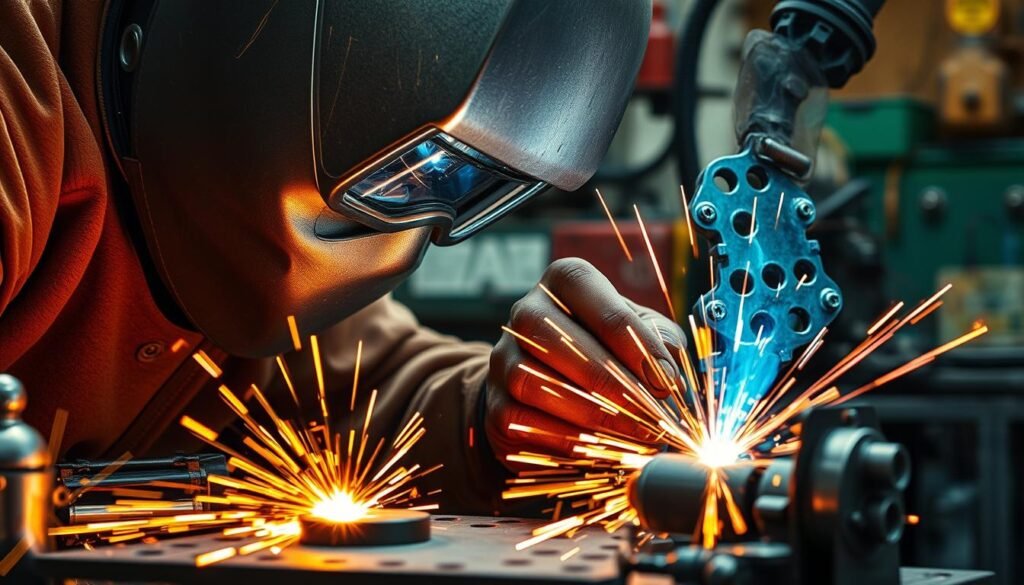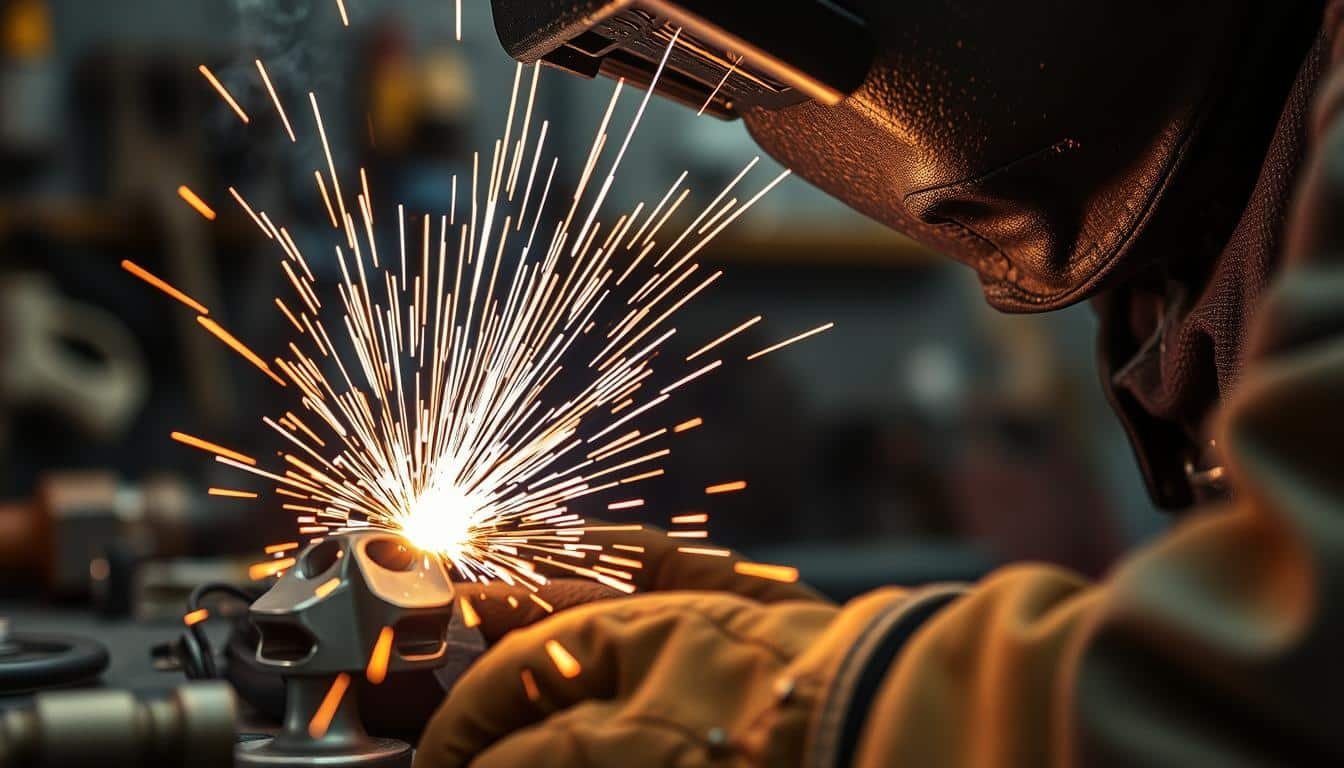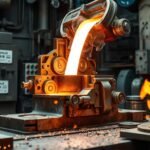Ever thought about fixing your favorite toys or decorations made of diecast metal? Die casting makes detailed and strong products. But, can you weld them? This guide will dive into diecast metal’s special traits, how to weld them, and expert tips for repairs.
Key Takeaways
- Die casting is a fast, efficient mass-production process using metal molds and high-pressure injection of molten metals like aluminum and zinc.
- Diecast metals have unique properties, such as high strength, excellent surface finish, and low melting points. They’re great for many uses.
- Welding diecast metal is tough because of its special makeup. But, with the right methods, you can fix and restore these items.
- Knowing the different types of die-cast metals and their properties is key. It helps choose the best welding method for success.
- Working together between designers, casters, and welders is vital. It’s especially important in the early stages of a project.
Understanding Die Cast Metal Properties and Composition
Die cast metals like aluminum, zinc, and their alloys are perfect for the die casting process. They melt easily and flow well, making it simple to shape them into detailed parts. These metals also have a mix of elements like copper, magnesium, and silicon. This mix gives them great properties.
Different Types of Die Cast Metals
The most common die cast metals include:
- Aluminum alloys
- Zinc alloys
- Magnesium alloys
- Copper-based alloys (brass and bronze)
Physical Properties and Characteristics
Die cast metals are known for being stable in size, having a smooth surface, and being able to make thin parts. These traits make them versatile and good for many uses, from car parts to gadgets. The exact properties of these metals depend on the mix of elements and how they are cast.
Common Applications in Manufacturing
Die cast parts are used a lot in cars, for things like engine blocks and brake calipers. They’re also in gadgets, home appliances, and other products. The die casting method makes it easy and cheap to make complex, high-quality parts for today’s needs.
“Die casting alloys offer mechanical properties equivalent to medium-strength metals, several times stronger and more rigid than plastics, with properties comparable to powder iron, brass, and low carbon steel.”
Can You Weld Diecast Metal: Methods and Techniques

Welding diecast metal is tough because it melts easily and can get porous. But, with the right methods, it’s doable. TIG (Tungsten Inert Gas) welding is best for thin diecast metal. You need an A/C TIG welder and the right filler rod for this.
MIG (Metal Inert Gas) welding works for thicker metal. Brazing and soldering are also good for some repairs. Always clean and prepare the metal well before welding.
When welding diecast metal, safety is key. The metal can release harmful fumes. Make sure you have good ventilation and wear protective gear, like a welding helmet.
Diecast Welding Techniques
- TIG Welding: Preferred for thin sections of diecast metal, requiring an A/C TIG welder with high-frequency start and a compatible filler rod.
- MIG Welding: Suitable for thicker sections of diecast metal.
- Brazing and Soldering: Alternative joining methods that may be suitable for some diecast metal repairs.
Choosing the right welding method is important. But, always prepare the surface well and follow safety rules. A safe, well-ventilated area and protective gear are musts for welding diecast metal.
“Die cast parts made from AlSi9MgMn (Silafont-36) are well suited for welding, including MIG and TIG methods and laser beam welding.”
Conclusion
Welding diecast metal is tricky because of its low melting point and brittleness. It’s also prone to contamination. But, with the right techniques and safety steps, you can weld it successfully.
The choice of welding method, like TIG or MIG, depends on the metal’s type and thickness. It also depends on what you want to achieve with the repair.
For diecast metal repair, brazing or soldering might be better. They are less likely to cause damage. Always remember, safety is key when working with these metals. They can release harmful fumes during welding.
Proper ventilation and protective gear are a must. A careful and measured approach is also crucial for a safe and successful repair.
Mastering diecast metal welding or repair takes skill and experience. Knowing the challenges and using the right techniques can lead to durable and high-quality results. This makes diecast metals a valuable and cost-effective choice for engineering projects.
FAQ
Can you weld diecast metal?
What types of die cast metals can be welded?
What welding methods are best for die cast metals?
How do you prepare diecast metal for welding?
What are the challenges of welding diecast metal?
Source Links
- The Die Is Cast! – https://hackaday.com/2023/03/01/the-die-is-cast/
- Common Questions About Zinc Die Casting | Dienamics – https://dienamics.com.au/blog/common-questions-zinc-die-casting/
- Die casting – https://en.wikipedia.org/wiki/Die_casting
- Design and Develoopment Sourcebook: Product Design for Die Casting – https://cwmdiecast.com/wp-content/uploads/2020/06/Die-Casting-Prod-Design-NADCA-min.pdf
- Foundry – Lexicon – https://www.giessereilexikon.com/en/foundry-lexicon/Encyclopedia/show/welding-of-die-cast-parts-4624/?cHash=3435085bd7535813cc4dd65edd595bfb
- Can You Weld Pot Metal? – https://www.arccaptain.com/blogs/article/can-you-weld-pot-metal?srsltid=AfmBOoqeNt-GWEPsaQMi_318ySwNlrHIiFwG00LgwuKduV9gCdyLf2jO
- Pot Metal Welding Repairs with Super Alloy 1: Matchbox Car Restoration – – https://www.muggyweld.com/knowledge-video/pot-metal-welding/
- Can You Weld Pot Metal? – https://www.arccaptain.com/blogs/article/can-you-weld-pot-metal?srsltid=AfmBOopKpbhxhtB3T-E8UqCYOqVA_KlOKGDzyzyOplP0T6Qen_h3J9TD
- Can You Weld Pot Metal? – Welding Tribe – https://www.weldingtribe.com/can-you-weld-pot-metal/
- What Is Zinc Die Casting? Benefits of Zinc Alloys in Casting – https://www.rapiddirect.com/blog/what-is-zinc-die-casting/








Interesting read. But isnt welding diecast metal risky due to its high zinc content and low melting point?
So, if we can weld diecast metal, could we theoretically do the same with other metals like gold or silver? Just curious.